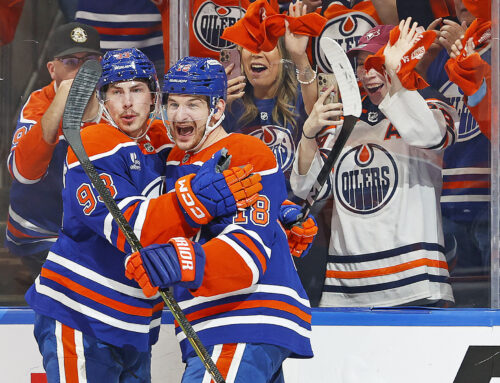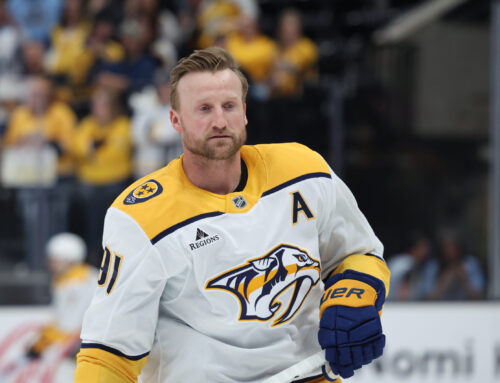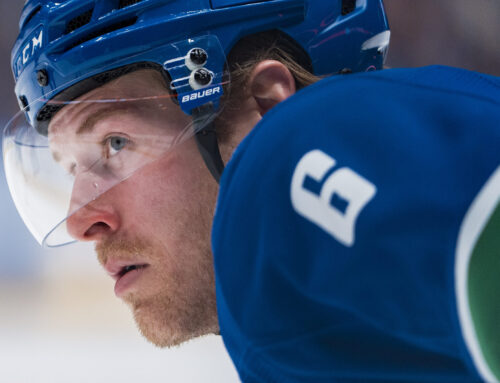
Deep Dive: Explaining shooting percentage and what it means to fantasy hockey.
(Editor's note: Although Rick Nash is in the Eastern Conference, he is a great example to use for changes in shot percentage)
Shooting percentage has become a major tool in fantasy hockey because of its potential ability to identify players due for a decline or a rebound season. When the only shot related data available was the number of shots it was acceptable to use shooting percentage as a lone factor in looking at regression related ups and downs. With more data now available it is necessary to look at the contributing factors to a player’s shooting percentage, just as not all shots are created equal neither are shooting percentages. This is the case because, as recent work on the subject has shown, distance and type of shot affect the likelihood that a shot will go in, what was once just common sense has now been quantified. Furthermore, it has also now been shown that certain players can affect their teammates’ shooting percentages. Thus it is no longer the case that a drop, or rise, in shooting percentage is a sign of a coming regression. With more information available shooting percentage changes can now be better broken down to determine what was luck and what was warranted. The rest of the column will be dedicated to the factors that can help to explain a change in a player’s shooting percentage beyond plain luck.
Shooting Percentage Factors
Shot Distance:
On Corsica.hockey you can look at how a players shot distribution has changed over time. For example the pictured show how Rick Nash’s shot distribution changed from 2014/15 when he had a shooting percentage of 12.83% at even strength to 2015/16 when he had a shooting percentage of 6.20%. Notice that in 2015/16 the higher shot density areas are farther away from the net than they were in 2014/15.

Figure 1: Rick Nash 2015/16

Figure 2: Rick Nash 2014/15
The shot report on here at Dobberhockey.com offers a more concrete breakdown of Nash’s shot distribution in your year of choice. From there we see that Rick Nash’s shot breakdown over the last two years is the following:
|
Season |
1- 15 Feet |
S/G |
16 – 30 Feet |
S/G |
31 – 45 Feet |
S/G |
%<30 FT |
|
2014/15 |
97 |
1.23 |
64 |
0.81 |
80 |
1.01 |
40.2% |
|
2015/16 |
61 |
1.02 |
52 |
0.87 |
40 |
0.67 |
40% |
From the Dobberhockey numbers it is evident that Nash was taking a lot more shots from what amounts to the slot area in 2014/15, an area where players generally score on 10% or more of their shots. Nash was shooting a lot more in general in 2014/15, to the tune of 3.35 more shots per 60 minutes than in 2015/16 with the major uptick coming on long distance shots as well as shots from close to the net. Shooting Percentage by Distance, an article on Edmonton Oilers blog ‘Boys on the Bus’ in 2013, found that shots from within 27 feet go in at above overall league average shooting percentages. Basically the article finds that a player has twice as good a chance of scoring on shots from within 15 feet as shots from more than 25 feet out. It helps that shots from close to the net also consist of rebounds, deflections, breakaways and shots off the rush, situations where the shooter naturally has an advantage. Looking at a distribution of a players shots is more important than looking at the average distance as Nash’s average shot distance was actually greater in 2014/15 than it was in 2015/16 because his long distance shots increased more proportionally than any other distance.
Scoring Chances:
Shot distance is not the only factor, although it is a very important one. Corsica.hockey has built on war-on-ice’s definition of scoring chances. War-on-ice used a point system where rebounds, one timers and shots off the rush were bumped up the general danger of a shot, therefore what would normally be a medium danger shot on war-on-ice became a high danger shot if it was one of the aforementioned typed of shot. Corsica.hockey bases his scoring chances based on their expected shooting percentage, which still uses zones but qualifies them slightly differently. Building on this idea of shot type having an a similar affect to shot distance Stephen Valiquette has been working on his Royal Road theory, explained here: http://www.msgnetworks.com/shows/hockey-night-live/chris-boyle/green–red-and-yellow-shots.html. Valiquette’s theory is that shots that come off the puck moving across the ice pass increase a player’s opportunity to score ten fold. Basically the idea is that shots that come off of situations where the goalie has to move have a greater probability of resulting in goals. It is slightly more detailed than that but basically rush shots, deflections, rebounds and one-timers account for a large percentage of what he defines as green goals. Back to Rick Nash here is a comparison of his scoring chance rate the last two seasons as well as the amount of rebound shots and rush shots he and in each of those years.
|
Season |
Scoring Chances/60 |
Rebounds |
Rush Shots |
|
2014/15 |
4.30 |
25 |
63 |
|
2015/16 |
3.44 |
18 |
38 |
This builds on the shot distance data in the last section as Nash had three quarter as many rebounds last year as the year before, a difference that the games he missed cannot explain in itself as he had fewer rebounds per game last year. The same trend exists for Nash in terms of rush shots, to a greater extent, as well and to similar extent in his scoring chance rate. It makes sense that with Nash taking a quarter shot fewer per game from in close that his rebound and rush shots would drop dramatically. It is likely that with any player who had a major change in their shot distribution, less close in shots, would experience a similar change in rebound and rush shots as those shots tend to occur in a specific area. While it is not possible to tell how many one-timers Nash took with the drop in his scoring chance rate we can assume by his overall numbers that those dropped as well.
Expected Goals:
Earlier in this column expected goals was briefly touched on indirectly when explaining Corsica’s scoring chance model. Expected goals is basically the number of goals a player could expect to score based on the number and type of shots that player has taken. This can be done just by binning shots by location to get a league average or by taking it a step further and by binning the shots by type as well as by location. Thus a player who significantly outperforms their expected goal rate is probably getting more than a little lucky, although many expected goal models slightly under predict for many players. Here are Rick Nash’s numbers for the last two years:
|
Season |
Expected Goals/60 |
Goals/60 |
|
2014/15 |
1.10 |
1.75 |
|
2015/16 |
0.93 |
0.64 |
Nash hugely outperformed his expected goal rate in 2014/15 and than vastly underperformed his expected goal rate this past year. Part of that is because of the aforementioned large increase in shots from the perimeter in concert with his increase in shots from in close. The rise in the shots from in close accounted for the huge amount of goals from in close but gets counter balanced by his shots from distance. Thus the expected goal rate was higher but not as much as you would expect given the difference in his shot rate from one year to the next.
Teammates:
This can be called the pass-first player effect, something that has been written about repeatedly in this column. The gist is that there are players who are able to raise the shooting percentages of their linemates by getting them the puck in situations and locations that are advantageous to the other player. This has shown by a number including David Johnson of stats.hockeyanalysis.com and Ryan Stimpson of The Passing Project. Both have shown that there are players who have higher on-ice shooting percentages repeatedly, thus they are able to raise the level of the players around them. It does not just have to be stars such as Henrik Sedin or Joe Thornton. Lesser pass-first players such as Mike Ribeiro and Scott Gomez can have a similar effect. These are generally players that have massive assist to goal ratio and will regularly have a high on-ice shooting percentage. They will also typically have a high relative expected goal rate, although that can also be said of the players playing with them, however these players will typically be consistently at, or near, the highest relative expected goal rate on their team. The better the player the more likely he is to raise his team’s on-ice shooting percentage regardless of the type of player he is, but it is more common for extreme pass-first players.
Conclusion:
Rick Nash was used as an example of how the underlying factors can explain a player’s drop in shooting percentage and potentially mitigate some of the expectations of a major rebound season. For Nash to rebound this season he needs to revert to the way he played in 2014/15 and start going to the net more, if he does not do so than a lower shooting percentage will simply become the norm for him. Nash is a handpicked example to serve a point, but there are many examples like him. There is far from a perfect correlation between shot distance, or scoring chances, and a player’s goals in a specific year but that is where regression comes into play over a year multi-year sample. That is also why it is dangerous to only look at shooting percentage because there is almost as strong as a correlation between scoring chance rate and goals rate as there is between shot rate and goal rate. The difference is that there is a much stronger correlation between scoring chance rate and shooting percentage than there is between shot rate and shooting percentage although both are very weak. Remember that shot quality and the ability to get into, and succeed in, those areas is a skill in and of itself that over the long haul will result in more goals, and therefore points.
3 Comments
Leave A Comment
You must be logged in to post a comment.





 FLA
FLA EDM
EDM MIN
MIN DAL
DAL UTA
UTA VAN
VAN STL
STL TOR
TOR L.A
L.A WSH
WSH

Theres no good excuse for the Rick Nash mistake other than I got caught up in him as a good example of my point.
Can I call it a preview of the top winger on the Las Vegas expansion? Does that pass mustard?
Maybe I’m missing something, but how exactly does one access the dobberhockey.com shot report for a player?
You can’t do ayer specific, the easiest way to do is it by team. That gets you a small manageable group.